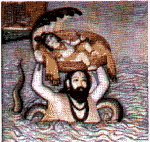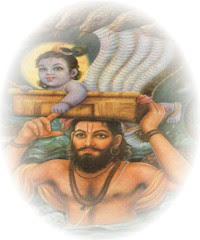 This has led to the Gita often being described as a concise guide to Hindu philosophy and also as a practical, self-contained guide to life. Other noted experts have described it as a lighthouse of eternal wisdom that has the ability to inspire any man or woman to supreme accomplishment and enlightenment. During the discourse, Krishna reveals his identity as the Supreme Being Himself (Svayam bhagavan), blessing Arjuna with an awe-inspiring glimpse of His divine universal form.The content of the text is a conversation between Krishna and Arjuna taking place on the battlefield of Kurukshetra just prior to the start of the Kurukshetra war.
This has led to the Gita often being described as a concise guide to Hindu philosophy and also as a practical, self-contained guide to life. Other noted experts have described it as a lighthouse of eternal wisdom that has the ability to inspire any man or woman to supreme accomplishment and enlightenment. During the discourse, Krishna reveals his identity as the Supreme Being Himself (Svayam bhagavan), blessing Arjuna with an awe-inspiring glimpse of His divine universal form.The content of the text is a conversation between Krishna and Arjuna taking place on the battlefield of Kurukshetra just prior to the start of the Kurukshetra war.
 Responding to Arjuna's confusion and moral dilemma, Krishna explains to Arjuna his duties as a warrior and Prince and elaborates on different and Vedantic philosophies, with examples and analogies. This has led to the Gita often being described as a concise guide to Hindu philosophy and also as a practical, self-contained guide to life.
Responding to Arjuna's confusion and moral dilemma, Krishna explains to Arjuna his duties as a warrior and Prince and elaborates on different and Vedantic philosophies, with examples and analogies. This has led to the Gita often being described as a concise guide to Hindu philosophy and also as a practical, self-contained guide to life. Other noted experts have described it as a lighthouse of eternal wisdom that has the ability to inspire any man or woman to supreme accomplishment and enlightenmentDuring the discourse, Krishna reveals his identity as the Supreme Being Himself (Svayam bhagavan), blessing Arjuna with an awe-inspiring glimpse of His divine universal form.
Other noted experts have described it as a lighthouse of eternal wisdom that has the ability to inspire any man or woman to supreme accomplishment and enlightenmentDuring the discourse, Krishna reveals his identity as the Supreme Being Himself (Svayam bhagavan), blessing Arjuna with an awe-inspiring glimpse of His divine universal form. The Bhagavad Gita is also called Gitopanishad as well as Yogopanishad, implying its status as an Upanishad, or a Vedantic scripture.Since the Gita is drawn from the Mahabharata, it is included in Smriti texts. However, being one of Upanishads, it has a status of śruti, or revealed knowledge
The Bhagavad Gita is also called Gitopanishad as well as Yogopanishad, implying its status as an Upanishad, or a Vedantic scripture.Since the Gita is drawn from the Mahabharata, it is included in Smriti texts. However, being one of Upanishads, it has a status of śruti, or revealed knowledge For historicity of the Mahabharata war, see: Mahabharata
For historicity of the Mahabharata war, see: MahabharataThe date of composition of the text of the Bhagavad Gita is not known with certainty, but is widely speculated as around 500 BCEScholars give a broad range of possible dates, as in this analysis by Robert Charles Zaehner:
As with almost every major religious text in India no firm date can be assigned to the Gītā. It seems certain, however, that it was written later than the 'classical' Upanishads with the possible exception of the Maitrī which was post-Buddhistic. One would probably not be going far wrong if one dated it at some time between the fifth and the second centuries B. C.
 However, it is interesting to note that the entire Mahabharata (of which Bhagavad Gita is a part of), has no references to Buddhism at all. Whereas the Buddhist scripture Niddesa written in 4 B.C. in the Pali Canon clearly refers to the worship of Vasudeva (Krishna) and Baladeva (Balarama). This itself might strongly suggest that the Bhagavad Gita is pre-Buddhistic. In fact, it is more likely that the Buddhists received the concept of Nirvana from earlier Vedic scriptures in Sanskrit
However, it is interesting to note that the entire Mahabharata (of which Bhagavad Gita is a part of), has no references to Buddhism at all. Whereas the Buddhist scripture Niddesa written in 4 B.C. in the Pali Canon clearly refers to the worship of Vasudeva (Krishna) and Baladeva (Balarama). This itself might strongly suggest that the Bhagavad Gita is pre-Buddhistic. In fact, it is more likely that the Buddhists received the concept of Nirvana from earlier Vedic scriptures in Sanskrit Based on claims of arbitrary differences in the poetic styles and supposed external influences such as Patanjali's Yoga Sutra,[citation needed] some scholars have argued that the Bhagavad Gita was added to the Mahabharata at a later date
Based on claims of arbitrary differences in the poetic styles and supposed external influences such as Patanjali's Yoga Sutra,[citation needed] some scholars have argued that the Bhagavad Gita was added to the Mahabharata at a later datetraditional religious dating for the events of the Mahabharata War according to the chronology established in Gupta times by Aryabhata on grounds of archaeoastronomical calculations places the Mahabharata (including the Bhagavad Gita) in the late 4th millennium BC (3138 BC or 3102 BC[13]). Many religious groups hold this date to be accurate in reference to the Gita.[14]















































